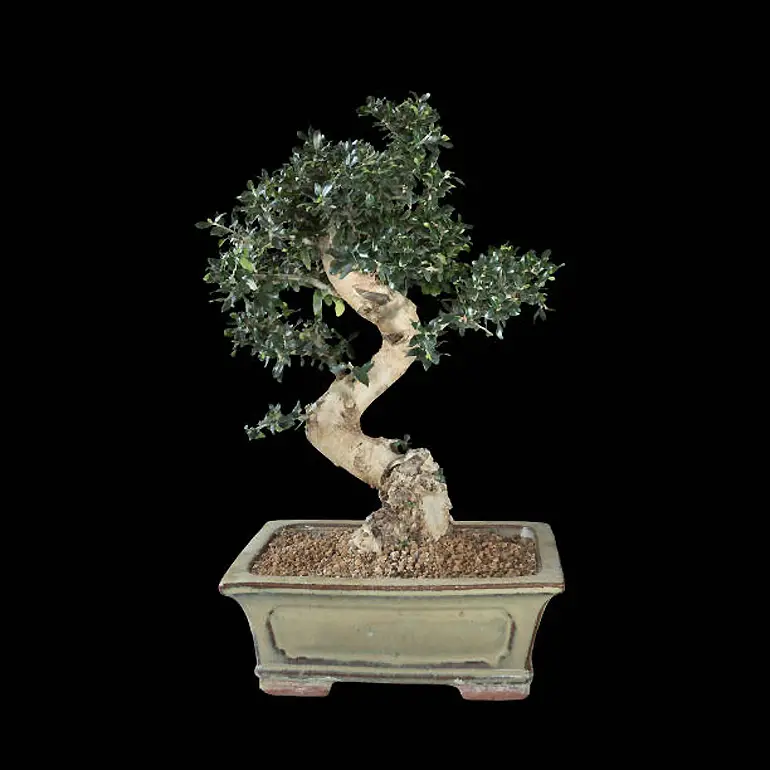Table of Contents
Black Olive (Bucida spinosa) – Many bonsai enthusiasts prefer trees with strong, angular lines and the Black Olive is an exceptional example of this form. Tiny leaves, sprinkled in a lacey pattern, allow the trunk line to be clearly seen. This tree prefers warm, sunny, indoor growing sites and does well in average home conditions.

Your 6 year old Black Olive Bonsai is an indoor bonsai and stands approximately 8 – 10 inches tall. A personalized message card and care information are included.
Black olive bonsai tree
Though commonly called ‘black olive tree’, this native of the upper Florida Keys (some consider it native, others do not) is not the edible olive we know and love, but does produce a small, black seed-capsule.
Black olive is a 40 to 50-foot-tall evergreen tree with a smooth trunk holding up strong, wind-resistant branches, forming a pyramidal shape when young but developing a very dense, full, oval to rounded crown with age. Sometimes the top of the crown will flatten with age, and the tree grows horizontally.
The lush, dark bluish-green, leathery leaves are two to four inches long and clustered at branch tips, sometimes mixed with the 0.5 to 1.5-inch-long spines found along the branches.
Bucida comes highly recommended by Lesniewicz, who says, “This delicate tree from Florida and the Caribbean grows into a bonsai almost by itself.” An unusual bonsai subject which may increase in popularity as an indoor tree. It is very salt tolerant, making it a good choice for bonsai lovers by the sea.
Black olive bonsai care
Family: Combretaceae
Black olive bonsai lighting
Full sun – its natural environment is the hottest parts of Florida and the Caribbean.
Black olive bonsai temperature range
Grows well in zones 10B through 11. Do not expose to freezing weather or better yet, temperatures below 40 degrees. A tender plant which has been grown successfully as an indoor bonsai.
Black olive bonsai watering
Likes to be well-watered and should not be permitted to stay dry.
Black olive bonsai fertilizing
Likes frequent fertilization which promotes vigorous growth.
Black olive bonsai pruning and wiring
New shoots need to be shortened only by a little. It is best to pinch them back. In nature, the Bucida is generally windswept, which makes this an excellent choice for bonsai style. The plant’s natural growth makes it ideal for bonsai. It changes direction at every internode, making a bend of 25 to 35 degrees, which can be incorporated into the styling.
Black olive bonsai propagation
From cuttings, as seeds are difficult to germinate. To propagate from cuttings, hard wood won’t work, even under a mist system. Soft wood ones will, but one rarely gets a soft wood cutting longer than 2 inches.
Propagation from seed. The tiny flower progresses to green seeds, then tan and then brown in about 2 months. Gather the seeds as soon as they fall, for they are more vital and willing to germinate in the first ten days after they ripen. Seeds should be planted in large community pots in a well drained mixture of vermiculite bonsai soil, peat and loam, and allowed 25 to 35 days for germination.
Be patient, for they grow very slowly. When they are 2 inches tall, transplant them from the community pot to individual pots. Cover each pot with a plastic bag for 5 days and put in the shade. Keep in the shade for 3 to 4 weeks, being careful to keep them moist, but watch for and avoid powdery mildew.
Once they are growing well, if you wish to force them to grow faster and taller than their usual 2 inches a year, bend down the branches lower than the growing tip. (Quoted from page 20, Vol 4, No. 4 of “Florida Bonsai” magazine.)
The best way to grow them from seed is to allow the seed to drop directly from the tree into a tray of soil without touching the seed. They rarely grow from cuttings with any size.
They can be grown from ‘tip’ cuttings (two or three clusters of leaves from the end of the branch). However, tip cuttings are best grown with an automatic mist system. Even then, many do not survive.
Black olive bonsai repotting
Repot in late winter, pruning roots only moderately. Use a fast draining bonsai soil with a high sand and lime content.
Black olive bonsai pests and diseases
No pests or diseases are of major concern but occasionally bothered by sooty mold and bark borer. Eryphide mites cause galls but no control is needed.
What species can turn into black olive bonsai
Bucida buceras: Bahama black olive
Bucida spinosa: spiny black olive, dwarf spiny black olive
![Pittosporum Bonsai [Pittosporum Tobira]](https://www.bonsai-express.com/wp-content/uploads/2022/05/Pittosporum-Bonsai-365x200.jpg)
![Sorbus Bonsai [Sorbus Aucuparia]](https://www.bonsai-express.com/wp-content/uploads/2022/05/Sorbus-Bonsai-365x200.jpg)
![Tsuga Bonsai [Tsuga Canadensis]](https://www.bonsai-express.com/wp-content/uploads/2022/05/Tsuga-Bonsai-365x200.jpg)
![Tamarix Bonsai [Tamarix Ramosissima]](https://www.bonsai-express.com/wp-content/uploads/2022/05/Tamarix-Bonsai-365x200.jpg)